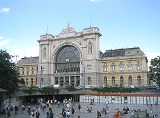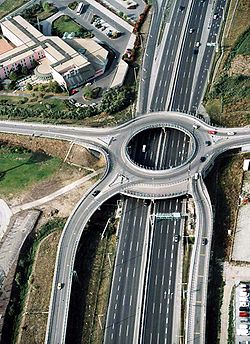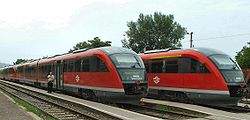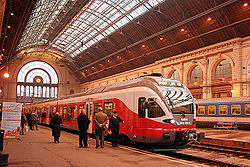
Transport in Hungary
Encyclopedia
Railways

- Total: 7,606 km
- Broad gaugeRussian gaugeIn railway terminology, Russian gauge refers to railway track with a gauge between 1,520 mm and . In a narrow sense as defined by Russian Railways it refers to gauge....
: 36 km gauge - Standard gaugeStandard gaugeThe standard gauge is a widely-used track gauge . Approximately 60% of the world's existing railway lines are built to this gauge...
: 7,394 km gauge (2,270 km electrified; 1,236 km double track) - narrow gauge: 176 km gauge (1998)
- Broad gauge
Note: Hungary and Austria
Austria
Austria , officially the Republic of Austria , is a landlocked country of roughly 8.4 million people in Central Europe. It is bordered by the Czech Republic and Germany to the north, Slovakia and Hungary to the east, Slovenia and Italy to the south, and Switzerland and Liechtenstein to the...
jointly manage the cross-border standard-gauge railway between Győr
Gyor
-Climate:-Main sights:The ancient core of the city is Káptalan Hill at the confluence of three rivers: the Danube, Rába and Rábca. Püspökvár, the residence of Győr’s bishops can be easily recognised by its incomplete tower. Győr’s oldest buildings are the 13th-century dwelling tower and the...
–Sopron
Sopron
In 1910 Sopron had 33,932 inhabitants . Religions: 64.1% Roman Catholic, 27.8% Lutheran, 6.6% Jewish, 1.2% Calvinist, 0.3% other. In 2001 the city had 56,125 inhabitants...
–Ebenfurt (GySEV/ROeEE), a distance of about 101 km in Hungary and 65 km in Austria.
In Budapest, the three main railway stations are the Eastern
Eastern Railway Station (Budapest)
Budapest Keleti pályaudvar , Hungarian for Budapest East railway station is the largest among the three main railway stations in Budapest...
(Keleti), Western
Western Railway Station (Budapest)
Budapest Nyugati pályaudvar is a railway station in the northern part of the Budapest City. It is one of the three main railway stations of Budapest and can be found in the 6th district.The station was planned by August de Serres and was built by the Eiffel Company...
(Nyugati) and Southern
Southern Railway Station (Budapest)
Budapest Déli pályaudvar or Budapest South railway station is the third largest railway station of Budapest, after Keleti pu and Nyugati pu. It can be found in the 1st district....
(Déli), with other outlying stations like Kelenföld
Kelenföld
Kelenföld is a neighborhood in Budapest, Hungary. It belongs to Újbuda, and located in the southern part of Buda. The large Kelenföld housing estate was built between 1967 and 1983 from pre-fabricated concrete blocks. The older streets around Bocskai út were mainly built in the first half of the...
. Of the three, the Southern is the most modern but the Eastern and the Western are more decorative and architecturally interesting.
Other important railway stations countrywide include Szolnok
Szolnok
Szolnok is the county seat of Jász-Nagykun-Szolnok county in central Hungary. Its location on the banks of the Tisza river, at the heart of the Great Hungarian Plain, has made it an important cultural and economic crossroads for centuries....
(the most important railway intersection outside Budapest), Tiszai Railway Station
Tiszai Railway Station
The Tiszai Railway Station, operated by Hungarian State Railways, is the largest of two railway stations of the city of Miskolc, Hungary. Despite its name, the station is not close to the river Tisza; it was named after the company that built it.-History:...
in Miskolc
Miskolc
Miskolc is a city in northeastern Hungary, mainly with heavy industrial background. With a population close to 170,000 Miskolc is the fourth largest city of Hungary It is also the county capital of Borsod-Abaúj-Zemplén and the regional centre of Northern Hungary.- Geography :Miskolc is located...
and the stations of Pécs
Pécs
Pécs is the fifth largest city of Hungary, located on the slopes of the Mecsek mountains in the south-west of the country, close to its border with Croatia. It is the administrative and economical centre of Baranya county...
, Győr
Gyor
-Climate:-Main sights:The ancient core of the city is Káptalan Hill at the confluence of three rivers: the Danube, Rába and Rábca. Püspökvár, the residence of Győr’s bishops can be easily recognised by its incomplete tower. Győr’s oldest buildings are the 13th-century dwelling tower and the...
, Debrecen
Debrecen
Debrecen , is the second largest city in Hungary after Budapest. Debrecen is the regional centre of the Northern Great Plain region and the seat of Hajdú-Bihar county.- Name :...
, Szeged
Szeged
' is the third largest city of Hungary, the largest city and regional centre of the Southern Great Plain and the county town of Csongrád county. The University of Szeged is one of the most distinguished universities in Hungary....
and Székesfehérvár
Székesfehérvár
Székesfehérvár is a city in central Hungary and is the 9th largest in the country. Located around southwest of Budapest. It is inhabited by 101,973 people , with 136,995 in the Székesfehérvár Subregion. The city is the centre of Fejér county and the regional centre of Central Transdanubia...
.
The only city with an underground
Rapid transit
A rapid transit, underground, subway, elevated railway, metro or metropolitan railway system is an electric passenger railway in an urban area with a high capacity and frequency, and grade separation from other traffic. Rapid transit systems are typically located either in underground tunnels or on...
railway system is Budapest
Budapest
Budapest is the capital of Hungary. As the largest city of Hungary, it is the country's principal political, cultural, commercial, industrial, and transportation centre. In 2011, Budapest had 1,733,685 inhabitants, down from its 1989 peak of 2,113,645 due to suburbanization. The Budapest Commuter...
with its Metro
Budapest Metro
The Budapest Metro is the rapid transit system in the Hungarian capital Budapest. It is the second-oldest underground metro system in the world after the London Underground. Its iconic Line 1, dating from 1896, was declared a World Heritage Site in 2002.-Lines:The Metro consists of three lines,...
.
In Budapest there is also a suburban rail
Regional rail
Commuter rail, also called suburban rail, is a passenger rail transport service that primarily operates between a city center, and the middle to outer suburbs beyond 15km and commuter towns or other locations that draw large numbers of commuters—people who travel on a daily basis...
service in and around the city, operated under the name HÉV
HÉV
Budapest HÉV is a system of four commuter rail and rapid transit lines in and around Budapest, Hungary. The HÉV lines were constructed as branch lines of the Hungarian State Railways...
.
Roads

- Total: 159,568 km
- Paved: 70,050 km (including 1515 km of motorways, as of 2011)
- Unpaved: 89,518 km (2005 est.)
Motorways
Motorways : M0M0 motorway (Hungary)
The M0 motorway is a ringroad around Budapest, the capital of Hungary. The ring presently connects motorways M1, M7, M6, M5, M4, M3, M2, connecting currently to Highway 11. The southern section of the ringroad currently does not comply with formal motorway specifications. The whole length of the...
- M1
M1 motorway (Hungary)
The M1 motorway is a long highway in northwestern Hungary, connecting Budapest to Győr and Vienna. The first section of the motorway opened in the 1970s, reaching the Austrian border at Hegyeshalom in 1996. It follows the route of the old Route 1 one-lane highway.- Junctions, exits and rest areas...
- M2
M2 motorway (Hungary)
The M2, or 2/A, is a Hungarian motorway connecting Budapest to Vác. It currently only operates until Dunakeszi as a motorway, from there it is a one-lane highway. It follows the original route of the no. 2 highway , towards the border with Slovakia....
- M15
M15 motorway (Hungary)
The M15 connects the M1 motorway to Bratislava, the capital of Slovakia. The Hungary-Slovakia border crossing is at Rajka and Čunovo ....
- M3
M3 motorway (Hungary)
The M3 is a Hungarian motorway connecting Budapest to Nyíregyháza. It will eventually connect Budapest to the Ukrainian border. Two other motorways branch off it, the M30 and the M35 . The M3 follows the route of route 3, and, later, route 4...
- M30
M30 motorway (Hungary)
The M30 is a Hungarian motorway that connects the M3 to Miskolc. It follows the route of the 3 one-lane highway. It was opened to the public on December 2, 2004....
- M35
M35 motorway (Hungary)
The 22 mile M35 motorway is a motorway in Eastern Hungary which connects the M3 motorway with the city of Debrecen, providing it with a direct motorway link to the capital, Budapest....
- M5
M5 motorway (Hungary)
The 108 mile long M5 motorway connects Budapest, the capital city of Hungary with the south-eastern regions of the country, the cities of Kecskemét, Szeged, and finally Röszke on the Serbian border...
- M6
M6 motorway (Hungary)
The M6 motorway is a north-south motorway in Hungary running along the Danube connecting Budapest to the seat of Baranya county Pécs, and further south to the Croatian border.Construction progress:...
- M7
M7 motorway (Hungary)
The M7 motorway is a Hungarian motorway which runs from Budapest towards the Croatian border at Letenye, reaching Székesfehérvár, then Siófok, a town on Lake Balaton, and the city of Nagykanizsa in the southwest of the country....
- M70
M70 motorway (Hungary)
The M70 motorway is a motorway in Hungary, connecting the M7 motorway to the A5 motorway in Slovenia. The last section was completed in 2006. After the opening of the last missing sections of the M7 on August 19, 2008, there is a direct motorway link from Budapest to Slovenia....
New motorway sections are being added to the existing network, that already connects many major economically important cities to the Capital City
Budapest
Budapest is the capital of Hungary. As the largest city of Hungary, it is the country's principal political, cultural, commercial, industrial, and transportation centre. In 2011, Budapest had 1,733,685 inhabitants, down from its 1989 peak of 2,113,645 due to suburbanization. The Budapest Commuter...
.
Ports and harbors
The most important port is BudapestBudapest
Budapest is the capital of Hungary. As the largest city of Hungary, it is the country's principal political, cultural, commercial, industrial, and transportation centre. In 2011, Budapest had 1,733,685 inhabitants, down from its 1989 peak of 2,113,645 due to suburbanization. The Budapest Commuter...
, the capital. Other important ones include Dunaújváros
Dunaújváros
Dunaújváros is a Hungarian city in Central Transdanubia, along the Danube river. It is in Fejér county.-History:Dunaújváros is one of the newest cities of the country...
and Baja
Baja, Hungary
Baja is a city in , southern Hungary. It is the second largest city in the county, after the county seat at Kecskemét, and is home to around 37,000 people....
.
Merchant marine
- Total: 2 ships (with a volume of or over) totaling /
- Ships by type: cargo shipCargo shipA cargo ship or freighter is any sort of ship or vessel that carries cargo, goods, and materials from one port to another. Thousands of cargo carriers ply the world's seas and oceans each year; they handle the bulk of international trade...
2 (1999 est.)
Airports
There are 43-45 airports in Hungary, including smaller, unpaved ones too. (1999 est.) The five international ones are Budapest-Liszt FerencBudapest Ferihegy International Airport
Budapest Liszt Ferenc International Airport , formerly known as Budapest Ferihegy International Airport, is the international airport serving the Hungarian capital city of Budapest, and the largest of the country's five international airports. The airport offers international connections primarily...
, Debrecen Airport
Debrecen International Airport
Debrecen International Airport is one of the five international airports in Hungary, located south southwest of Debrecen.- History :The history of Debrecen Airport goes back to the early 20th Century. The first official regular flight carrying mail took off in 1930. Subsequently the Airport...
, Sármellék Airport
Sármellék International Airport
Sármellék International Airport , also known as FlyBalaton Airport, is an international airport in Hungary located west of Lake Balaton south-southwest of the village of Sármellék, Zala County and Keszthely...
(also called FlyBalaton for its proximity to Lake Balaton
Lake Balaton
Lake Balaton is a freshwater lake in the Transdanubian region of Hungary. It is the largest lake in Central Europe, and one of its foremost tourist destinations. As Hungary is landlocked , Lake Balaton is often affectionately called the "Hungarian Sea"...
, Hungary's number one tourist attraction), Győr-Pér
Gyor-Pér International Airport
Győr-Pér Airport is a public commercial airport with international operation capability. The airport is located on highway 81, about 15 km from Györ city centre. It lies next to route 81 towards Szekesfehervar, easily accessible from the M1 highway. The direction of the airport is shown by...
and Pécs-Pogány. MALÉV Hungarian Airlines
Malév Hungarian Airlines
Malév Hungarian Airlines is the flag carrier and principal airline of Hungary. It has its head office in the Lurdy House in Budapest, with its main operations at Budapest Ferenc Liszt International Airport. From there, the airline flies to 50 cities in 34 countries worldwide using a fleet of 22...
operates flights to over 60, mostly European cities.
Airports with paved runways
- Total: 16
- Over 3,047 m: 2
- 2,438 to 3,047 m: 8
- 1,524 to 2,437 m: 4
- 914 to 1,523 m: 1
- Under 914 m: 1 (1999 est.)
Airports with unpaved runways
- Total: 27
- 2,438 to 3,047 m: 3
- 1,524 to 2,437 m: 5
- 914 to 1,523 m: 12
- Under 914 m: 7 (1999 est.)
Heliports


Transport companies of cities
- BKVBKVBKV is the unified public transport company of Budapest, established in 1968...
(BudapestBudapestBudapest is the capital of Hungary. As the largest city of Hungary, it is the country's principal political, cultural, commercial, industrial, and transportation centre. In 2011, Budapest had 1,733,685 inhabitants, down from its 1989 peak of 2,113,645 due to suburbanization. The Budapest Commuter...
) (buses, trams, trolley buses and metro) - DKV (DebrecenDebrecenDebrecen , is the second largest city in Hungary after Budapest. Debrecen is the regional centre of the Northern Great Plain region and the seat of Hajdú-Bihar county.- Name :...
) (buses, trams & trolley buses) - MVK Zrt.MVK Zrt.MVK Zrt. is the name of the transport company of the city of Miskolc, Hungary. Unlike the transport companies of many other cities, MVK Zrt...
(MiskolcMiskolcMiskolc is a city in northeastern Hungary, mainly with heavy industrial background. With a population close to 170,000 Miskolc is the fourth largest city of Hungary It is also the county capital of Borsod-Abaúj-Zemplén and the regional centre of Northern Hungary.- Geography :Miskolc is located...
) (buses and trams) - SzKT (SzegedSzeged' is the third largest city of Hungary, the largest city and regional centre of the Southern Great Plain and the county town of Csongrád county. The University of Szeged is one of the most distinguished universities in Hungary....
) (trams & trolley buses only; buses belong to Tisza Volán) - PK Rt. (PécsPécsPécs is the fifth largest city of Hungary, located on the slopes of the Mecsek mountains in the south-west of the country, close to its border with Croatia. It is the administrative and economical centre of Baranya county...
) (buses) - KT Rt. (Kaposvár) (buses)
In the rest of the cities and towns local transport is provided by Volán companies that also provide intercity bus lines.
Trams and Light Rail
The busiest traditional city tram line in the world is still route 4/6 in BudapestBudapest
Budapest is the capital of Hungary. As the largest city of Hungary, it is the country's principal political, cultural, commercial, industrial, and transportation centre. In 2011, Budapest had 1,733,685 inhabitants, down from its 1989 peak of 2,113,645 due to suburbanization. The Budapest Commuter...
, Hungary
Hungary
Hungary , officially the Republic of Hungary , is a landlocked country in Central Europe. It is situated in the Carpathian Basin and is bordered by Slovakia to the north, Ukraine and Romania to the east, Serbia and Croatia to the south, Slovenia to the southwest and Austria to the west. The...
, where 50-meter long trains run at 60 to 90 second intervals at peak time and are usually packed with people. A part of this route is the same as where electric trams made their world first run in 1887. Budapest has recently ordered 40 Siemens Combino Supra
Combino Supra
The Combino Supra , Combino MkII, or Combino Plus is a new Combino model made of stainless steel instead of light materials, and manufactured at a new assembly line in Vienna.-Design differences with original Combino:...
low floor trams. Trams began carrying the passengers on the 1 July 2006 but during the first weeks there were many technical difficulties.
Cities with tram lines
- Budapest (since November 28, 1887)
- Miskolc (since July 10, 1897)
- Szeged (since October 1, 1908)
- Debrecen (since March 16, 1911)
Cities with former tram lines
- Szombathely (1897–1974)
- Sopron (1900–1923)
- Nyíregyháza (1905–1969)
- Pécs (1913 – August 31, 1960)
There were some towns, where narrow gauge railways were used as tram lines or interurban
Interurban
An interurban, also called a radial railway in parts of Canada, is a type of electric passenger railroad; in short a hybrid between tram and train. Interurbans enjoyed widespread popularity in the first three decades of the twentieth century in North America. Until the early 1920s, most roads were...
lines (for example: Sárospatak
Sárospatak
----Sárospatak is a town in Borsod-Abaúj-Zemplén county, northern Hungary. It lies northeast from Miskolc, in the Bodrog river valley. The town, often called simply Patak, is an important cultural centre.- History :The area has been inhabited since ancient times...
, Sátoraljaújhely
Sátoraljaújhely
Sátoraljaújhely or אוהעלי ) is a town located in Borsod-Abaúj-Zemplén county in northern Hungary near the Slovak border. It is east from the county capital Miskolc.- History :...
, Békéscsaba
Békéscsaba
Békéscsaba is a city in Southeast Hungary, the capital of the county Békés.- Geography :According to the 2001 census, the city has a total area of .- Name :...
, Békés
Békés
Békés is a town in Békés county, Hungary. It lies about north of Békéscsaba and east of Budapest.- History :The area of the present town has been inhabited since ancient times, due to its good soil and proximity to rivers. After Hungarians conquered the area, Békés and its surroundings were the...
, Cegléd
Cegléd
Cegléd is a city in Pest county, Hungary, approximately southeast of the Hungarian capital, Budapest.-Name:There are discussions going on about the origin of the name of the town...
). These lines were closed in the 1970s.
See also
- HungaryHungaryHungary , officially the Republic of Hungary , is a landlocked country in Central Europe. It is situated in the Carpathian Basin and is bordered by Slovakia to the north, Ukraine and Romania to the east, Serbia and Croatia to the south, Slovenia to the southwest and Austria to the west. The...
- Hungarian State RailwaysHungarian State RailwaysHungarian State Railways is the Hungarian national railway company, with divisions "MÁV Start Zrt" and "MÁV Cargo Zrt" ....
- List of airports in Hungary
- List of motorways in Hungary
- Suburban railway lines in BudapestHÉVBudapest HÉV is a system of four commuter rail and rapid transit lines in and around Budapest, Hungary. The HÉV lines were constructed as branch lines of the Hungarian State Railways...

